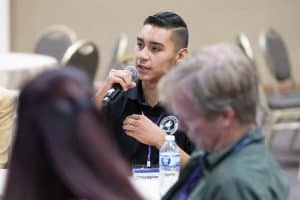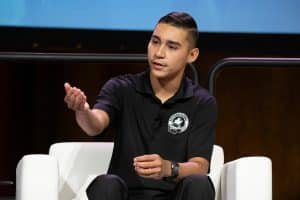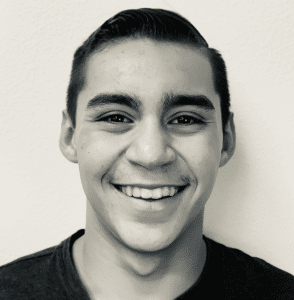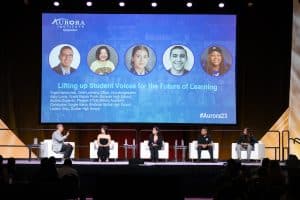A Student Experience in a Personalized, Career-Focused Competency-Based Model
CompetencyWorks Blog
Hello everyone, I am a 15-year-old sophomore at Bostonia Global High. My name is Christopher Vargas Ibarra, and I want to share my student experience in a personalized, competency-based school. Before that, a few fun facts about me.
- I am from Connecticut and moved to California when I was around six.
- My interests are with automobiles, working with my hands, and computers.
- I aspire to be an automotive engineer in the future.
- I always liked to work with mechanics as a kid.

Alright, enough about me; let’s get back to the student experience. At first, like some people, I was a little skeptical and confused with the grading system at Bostonia. I had never heard of a competency-based education (CBE) school before, but hearing that it was personalized, I wanted in because I believe strongly in the student rather than the curriculum. So I went to the summer school at Bostonia Global High, and I started to like it more and more. After a month or two of being in a CBE school, I was hooked.
Designed for Relevance and Support
One moment that I recall where I experienced personalized support was when my advisor (yes, we actually don’t call them teachers) had a one-on-one with me about my project in her class, which was called ‘CLEAR Models’ (Career, Learning Intentions, Experience, Activity, and Reflection). These ‘CLEAR Models’ are used to research the careers we are potentially interested in. My advisor helped me a lot through that project by using different ideas that align with my interests like bringing an engine to school. With my automotive knowledge and my advisor’s background in education, we spent time brainstorming to create my project. It was really different from what I was used to at middle school and what I was seeing at other high schools. I liked the change of environment a lot because the school really gave so much support, and this new idea of learning competencies through my own interests really impacted my outlook on education.
Mentorships at Bostonia Global
My mentorship at the City of El Cajon: Fleet Maintenance is memorable because it aligns perfectly with my goals and interests. I always wanted to work in the automotive industry. My mentorship has shown me what a day in the life of an auto mechanic is like. This mentorship has a little bit of an interesting story to it, too. Previously we had an event called the ‘Work-Based Learning Fair’ where companies from around San Diego came to our school. That is where I was introduced to the City of El Cajon, where I had a lot of interest, but I already had a mentorship on the line. Unfortunately, as with things in life, not everything goes to plan, and I didn’t get the first mentorship. Thankfully, my World of Work Coordinator saved me by talking to me about potentially mentoring at the City of El Cajon. I was interested since it aligned with my interests, and we decided to email my resume to them. I got the good news that I was accepted to the program.
My relationship with my aforementioned Coordinator was essential because she really went out of her way for me to get my mentorship. She also had connections within the City of El Cajon, and they really liked who I was. That is where my love for automobiles really skyrocketed. I had always wondered what it was like to work in the automotive industry, and the mentorship really showed that. This unconventional idea of getting a mentorship in my high school looks like this:
- Get to know what industry or job you would like to work in.
- Research the industry to see if there is anyone nearby.
- Either add them or request them to the app named ImBlaze, which is where we can monitor our mentorships.
- Get in touch with their higher-ups to potentially be mentored by them, sometimes with a cold call (I know it might be a bit tedious). If they think you’re a strong candidate or do have a mentorship program, you can send a resume to help them know your full working self and go to step five. If not, then that is okay. We all aren’t meant to have a mentorship immediately.
- Go in to have a shadow day in the facility of that company. Obviously, it depends if you both have a good fit for each other. Keep in mind you can and will talk to your advisor about all of this, and that is really helpful.
Getting Used to CBE
 High school is my first ever time doing competency-based learning, so I have a lot of experience with the traditional way of education. The CBE system was very different for me because I always had to stress about getting good grades in a traditional school. The competencies were really confusing at first because I was used to the normal system of number and letter grades. Luckily the advisors coached me into understanding the system. For example, there is one competency called ‘Iteration’ where to demonstrate it, you can either show some prototypes at the end-of-the-year presentation or take photos of your work in progress over several stages. This goes for all the other ‘Competencies’ and ‘Learning Goals.’ Everyone in the school is an advisor, so if you have any questions, they can help out or refer you to someone who can in the school.
High school is my first ever time doing competency-based learning, so I have a lot of experience with the traditional way of education. The CBE system was very different for me because I always had to stress about getting good grades in a traditional school. The competencies were really confusing at first because I was used to the normal system of number and letter grades. Luckily the advisors coached me into understanding the system. For example, there is one competency called ‘Iteration’ where to demonstrate it, you can either show some prototypes at the end-of-the-year presentation or take photos of your work in progress over several stages. This goes for all the other ‘Competencies’ and ‘Learning Goals.’ Everyone in the school is an advisor, so if you have any questions, they can help out or refer you to someone who can in the school.
Also, being able to argue for the competencies to be leveled up was really interesting because, in one class, you can be great in one competency and not excel in another. Still, in a different class, you can do that competency better and argue to move it up by showing empirical evidence that you have achieved those requirements. So the advisors all can advocate for you, which is really cool!
Insights From a Student
Some advice that I would give to educators about designing a similar environment is to realize that not everyone’s the same, so we don’t learn the same way. It also benefits scholars (what Bostonia Global calls their students) to engage our interests and build a relationship with them. We can build this relationship by having a class that is set for a student’s entire high school life with our main advisor in both the morning and the afternoon that can help with any of the student’s work. If you want to take it even further, you can put students from different grades in the class so not only is it more diverse, but you can also have a higher chance of creating a family-like class. This might be scary as it’s a little new, and in some parts, you might even fail. In failure, there is room for improvement to change or to adapt. Sometimes, you have to lose some battles to win the war.
Wow, what a very long essay. I thank you so much for reading this to the absolute end. You deserve the most enjoyable snack, and I hope you have a wonderful rest of your day!
Learn More
- Using My Voice to Shape My High School
- From Memorizing for Tests to Learning for Life
- The Power of Work-Based Learning in Competency-Based Education
 Christopher Vargas Ibarra is a sophomore at Bostonia Global High School. He is passionate about hands-on work, especially when it comes to cars and connecting with people. He has been honing his automotive skills through hands-on experience and helping his parents and uncle replace car parts. His dream is to work in the automotive industry, focusing on repairing mechanical components like engines in cars and airplanes. Additionally, he enjoys drawing and designing systems in his free time. His goal is to combine his technical skills and creativity to make a meaningful impact in the world of automobiles. At the Aurora Institute Symposium 2023, he participated in a session about Cajon Valley Union School District and was a student panelist in the plenary session.
Christopher Vargas Ibarra is a sophomore at Bostonia Global High School. He is passionate about hands-on work, especially when it comes to cars and connecting with people. He has been honing his automotive skills through hands-on experience and helping his parents and uncle replace car parts. His dream is to work in the automotive industry, focusing on repairing mechanical components like engines in cars and airplanes. Additionally, he enjoys drawing and designing systems in his free time. His goal is to combine his technical skills and creativity to make a meaningful impact in the world of automobiles. At the Aurora Institute Symposium 2023, he participated in a session about Cajon Valley Union School District and was a student panelist in the plenary session.
